Rise of Emotional AI: Key Players and Patent Trends
Artificial Intelligence (AI) is no longer limited to solving mathematical problems and crunching numbers; it has evolved to create meaningful connections. The advancements in AI computing, specifically in Emotional AI, have enabled machines to understand and appropriately respond to human emotions in ways never seen before. This advancement has revolutionized the interaction between humans and technology, from customer service chatbots that can perceive frustration to virtual personal assistants that adapt to users’ moods. Emotional AI adds a sentimental component to text-based interaction by incorporating sentiment analysis and emotion recognition into the language model. This development of Emotional AI has ushered us into an era where we can explore the limitless potential of machines with the capacity to experience feelings.
This article provides an overview of Emotional AI, including its working principles and applications. It also explores the emotion detection and recognition market and highlights patent trends in this space. Let us begin by understanding the meaning of Emotional AI.
Table of Contents
What Exactly is Emotional AI?
Emotional AI, also known as affective computing, is a subfield of AI that focuses on developing technology capable of recognizing, understanding, and responding to human emotions. It utilizes machine learning algorithms and natural language processing techniques to analyze facial expressions, tone of voice, and other physiological signals to determine an individual’s emotional state. A core concept of Emotional AI is sentiment analysis which aims to identify whether a person’s sentiment is positive, negative, or neutral. However, accurately determining a person’s sentiments can be difficult due to the variability in words’ meanings across different contexts. To address this issue, Emotional AI considers numerous factors when analyzing speech, text, or facial features.
When analyzing speech, Emotional AI considers voice tones, vocal pitch, speed, and elongated pauses, to determine the underlying sentiment. In text-based applications, Emotional AI analyses the sentence as a whole and detects the context with some specific words to ascertain the nature of the person’s sentiment.
Emotional AI plays a vital role in the development of technology capable of understanding human emotions and responding appropriately. By leveraging AI computing techniques, Emotional AI enhances the capability of machines to recognize and interpret human emotions, paving the way for more empathetic interactions and elevated user experiences.
Now that we have understood what Emotional AI is and how it analyzes human emotions, let us explore its working in different modalities.
Working on Emotional AI
Emotional AI can be of various types, such as Text, Audio, Voice, Video and Multimodal. Text Emotional AI analyses written words. For instance, it can analyze text found in online comments or news stories and assess whether the content conveys a predominantly positive or negative sentiment.
Audio and voice Emotional AI analyzes human speech. This type of Emotional AI can help assess and track customer service calls to determine the vocal patterns of conversations as well as the content. Video and multimodal Emotional AI is used to process video signals ranging from eye movement to body language.
Incorporating Emotional AI provides unmatched advantages as it empowers machines to not only understand but also respond to human emotions, thereby fostering more empathetic interactions and elevating user experiences to new heights. In the following section, we will delve into the diverse advantages of Emotional AI and explore its applications in various contexts.
Advantages of Emotional AI
Emotional AI, as a part of AI computing, is revolutionizing how way we interact with technology, and numerous areas of the world are benefiting from its implementation. Here are some critical advantages of Emotional AI:
- Enhanced Customer Experience: Emotional AI can improve customer experiences by allowing chatbots and virtual personal assistants to comprehend and react to human emotions in real-time, increasing customer satisfaction and brand loyalty.
- Improved Insights: Emotional AI can process vast amounts of data and provides real-time insights into human emotions, enabling companies to make informed decisions about their products and services based on a deeper understanding of their target audience.
- Mental Health Benefits: Emotional Artificial Intelligence has the potential to revolutionize the approach to mental health by providing individuals with virtual therapists capable of understanding and responding to their emotional needs.
- Increased Employee Engagement: Emotional AI can improve team collaboration and increase employee engagement, reducing burnout and enhancing job satisfaction.
- Advancements in Gaming and Entertainment: Emotional AI is making waves in the gaming sector to create more interactive and immersive gaming experiences that respond to player emotions and adapt the game’s difficulty based on their moods.
- Personalization: It can also provide personalized experiences by adapting to an individual’s emotional state, leading to more relevant and meaningful interactions.
These advantages highlight the transformative potential of Emotional AI within the broader field of AI computing in various areas, ultimately enhancing human-computer interactions and improving overall well-being.
Application Areas of Emotional AI
Emotional AI has pervaded countless domains with its profound impact, revolutionizing how we interact with technology and understand human emotions. Here are some key application areas of Emotional AI:
1. Healthcare
Machines are increasingly becoming more helpful, but what if they could also begin to have emotions similar to humans? Empathetic devices, which may be present for each individual at all times, are created when machines integrate with the ability to feel and understand similar to humans. In mental health, this feature of Emotional AI is already in use. The incorporation of Emotional AI can offer a more individualized and successful treatment for mental health and for patients undergoing therapies.
Here are some notable applications of Emotional AI in healthcare:
- We are witnessing the advent of virtual mental health assistants using Emotional AI algorithms to support individuals suffering from mental health issues, such as depression and anxiety. These assistants offer empathetic interactions and can be available whenever individuals need them, surpassing the limitations of human availability.
- Companies are developing apps and devices using Emotional AI to track the moods of users over time. This information can be valuable to healthcare professionals as they can monitor the progress of individuals undergoing mental health treatment and adjust their treatment plans accordingly.
- Companies are also using Emotional AI to assist healthcare professionals in diagnosing mental health by analyzing patterns in the patient’s behavior, speech, and emotions. It can shorten the time required to make a diagnosis and improve the accuracy of the diagnosis.
- Emotional AI can help personalize treatment plans for individuals with mental health conditions. This cutting-edge technology can analyze the patient’s emotional state and suggest the most suitable therapy or medication based on their needs. This personalized approach has the potential to increase treatment outcomes and patient satisfaction.
Many digital health ventures are embracing the use of Emotional AI in their platforms. One notable example is Twill which has incorporated AI into its intelligent healing platform. Their health chatbot, “Taylor,” is a clinically trained therapeutic assistant that learns, interprets, and guides users toward more personalized care.
2. Marketing and Customer Service
Marketing is progressively utilizing emotional AI to comprehend and emotionally connect with customers. Examples of marketing applications for Emotional AI include:
- Sentiment Analysis: Emotional AI can help analyze user-generated content such as social media posts, customer reviews, and other content to determine the sentiment present. This information can help marketers better comprehend the feelings and perspectives of their clients towards their goods and services.
- Personalization: Emotional Artificial Intelligence enables tailoring communications to a customer’s emotional state. By leveraging Emotional AI, businesses can personalize their interactions with customers by effectively understanding and adapting to their emotional needs. This personalized approach enhances customer satisfaction and strengthens the overall customer experience.
- Chatbots: By leveraging Emotional AI, chatbots can communicate with clients that are more like human interaction, recognizing and responding to their emotions or emotional state. This enhanced capability leads to improved customer experiences and higher levels of satisfaction. Additionally, it enables businesses to build stronger connections with their clientele and foster long-term relationships based on empathy and understanding.
- Picture and Video Recognition: Emotional AI can analyze images and videos to determine the emotions that the subjects are displaying. It is being used to analyze customer responses to various forms of visual content.
Several international companies/brands, such as Coca-Cola, Nestlé, McDonald’s, and L’Oréal, have started incorporating the use of Emotional AI in their marketing strategies by analyzing social media content to provide users with a more personalized experience through Emotional AI.
3. Education
Emotional AI is also witnessing staggering use in education to support students and educators in understanding and managing emotions effectively. Here are some examples of how Emotional AI is being used in education:
- Student Assessment: Emotional AI can evaluate students’ emotional states and offer information about their emotional health. It can aid educators in identifying students who may require additional support and resources.
- Personalized Learning: Emotional AI considers a student’s emotional state to customize learning experiences. For instance, AI may offer relaxing exercises or alternative learning approaches if a student feels nervous.
- Virtual Assistants: These assistants, powered by Emotional AI, can interact with students in a manner that is similar to human interaction by understanding and responding to their emotions. It can create more comfortable and engaging educational experiences for students.
- Social-Emotional Learning (SEL): By offering feedback and insights into students’ emotional experiences, Emotional AI can improve social-emotional learning. This can assist the student in improving their emotional management and developing emotional intelligence.
- Mental Health Support: Emotional AI can assist students with anxiety, depression, or other mental health challenges. It can help students in obtaining the assistance they require to control their emotions and enhance their well-being.
Overall, Emotional AI can help educators to create supportive and engaging learning environments that foster the development of student’s emotional intelligence and health. These skills are crucial for their success in school and life beyond the classroom.
4. Gaming
Emotional AI in gaming and entertainment has rapidly grown in recent years, enabling more engaging and personalized user experiences.
One of the most prominent examples of Emotional AI in gaming is the use of facial recognition technology to track players’ emotions and dynamically adjust the game accordingly. For instance, if a player becomes frustrated, the game could adapt by becoming easier to prevent them from quitting. Alternatively, if a player feels confident, the game could increase its difficulty to keep them engaged.
Another application of Emotional AI in gaming involves the development of intelligent virtual characters capable of interacting with players in more realistic ways. These characters can recognize and respond to emotions expressed by players, making the gameplay experience more immersive and personalized.
In the entertainment industry, Emotional AI personalizes content recommendations based on viewers’ emotions. For instance, streaming services can analyze a user’s facial expressions to determine which shows or movies will resonate with them emotionally.
Emotiv is a company specializing in developing Emotional AI technologies for gaming. Their flagship product, the “Emotiv Insight,” is a brain-sensing headset that leverages EEG technology to track players’ emotions in real time. The headset can measure various metrics, such as excitement, stress, and focus, and utilize them to adjust the game accordingly.
Hence, the use of Emotional AI in gaming and entertainment has the potential to create highly immersive and personalized experiences for users, ultimately leading to increased engagement and satisfaction. However, there are also privacy problems and the ethical implications of collecting and analyzing users’ emotions.
In addition to this, Emotional AI finds its application in various other areas as well, such as virtual personal assistants, human resource management, health and wellness, and many others. In the following section, we will delve into the noteworthy advancements and growth of Emotional AI.
Growth of Emotional AI
Emotional AI has experienced rapid growth in recent years, reflecting the increasing importance placed on understanding and responding to human emotions across various industries. According to a recent study, the global market for emotion detection and recognition was estimated at USD 32.95 billion in 2021 and is predicted to increase at a CAGR of 16.7% from 2022 to 2030.
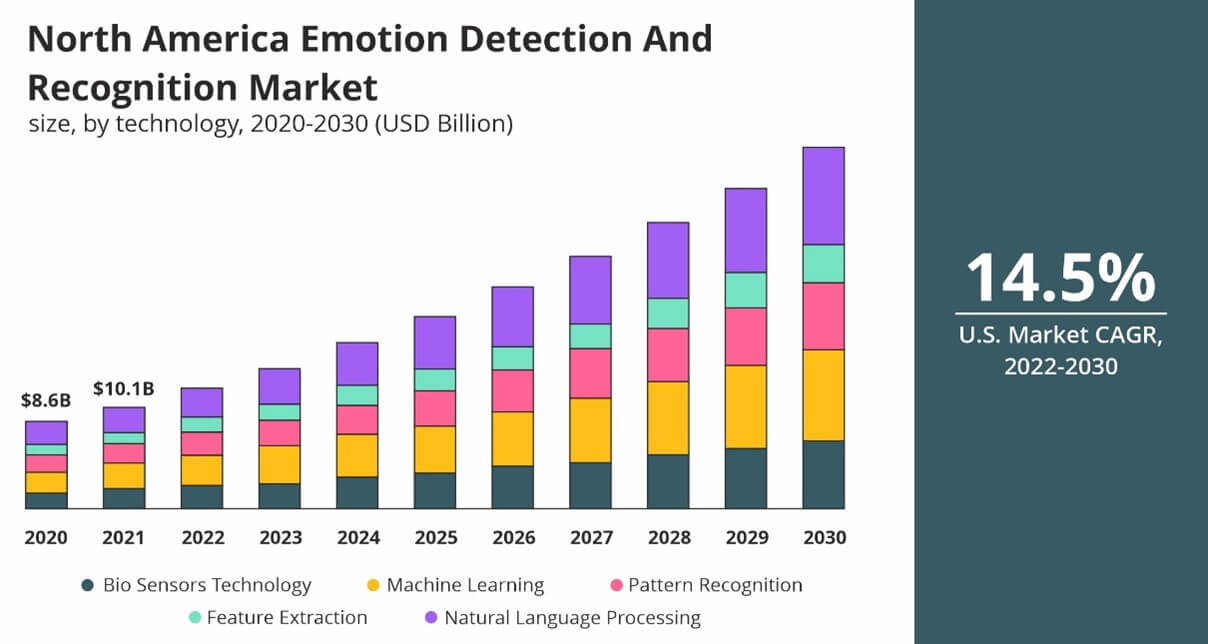
In 2021, the speech and voice recognition segment held the largest market share at 43.8%. Additionally, facial expression and recognition technologies provide fast and accurate results, reliable matching, a non-contact process, and diverse applications, including border control, crime fighting, law enforcement agencies, and access control.
In terms of revenue, the healthcare and life sciences sector dominated the market, holding the highest share of 20.7% in 2021. The market can also be categorized by end-use vertical, with BFSI, healthcare and life sciences, IT and telecommunication, retail and e-commerce, education, media and entertainment, automotive, and other divisions.
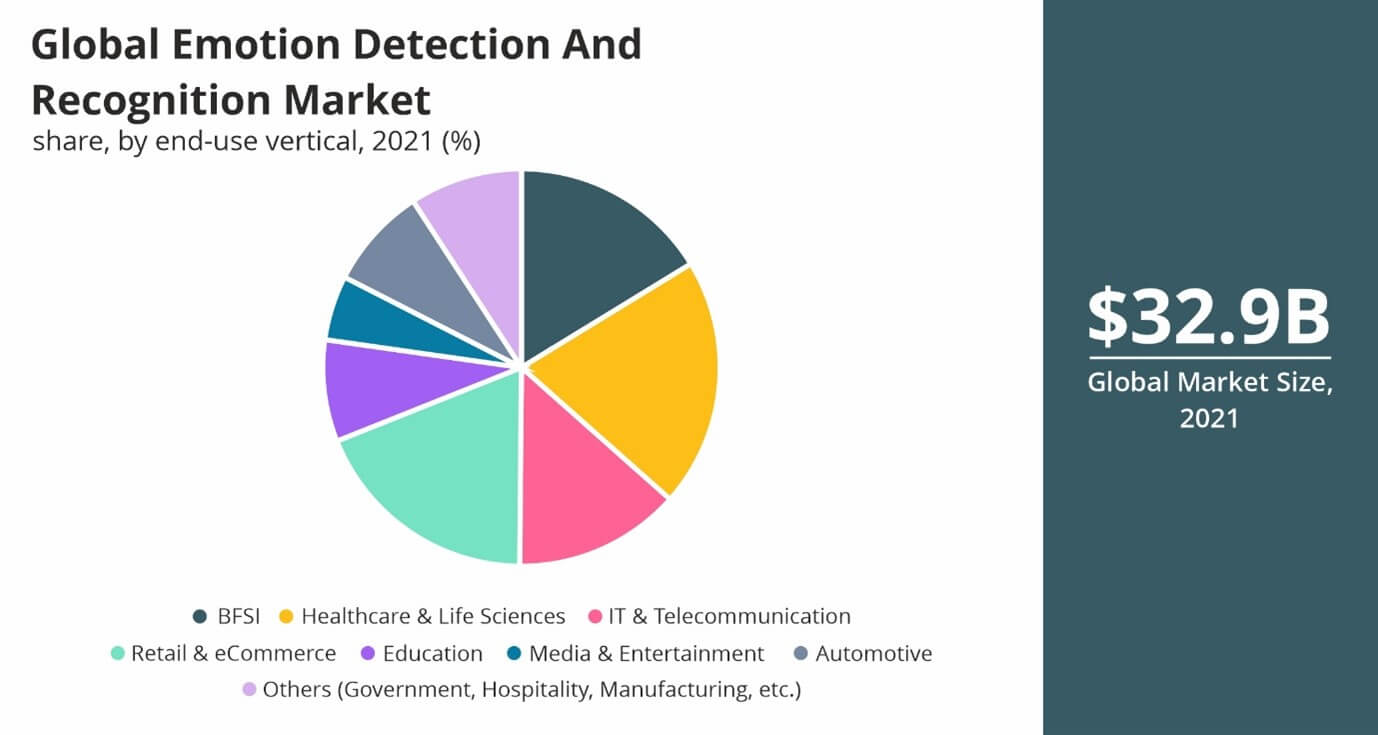
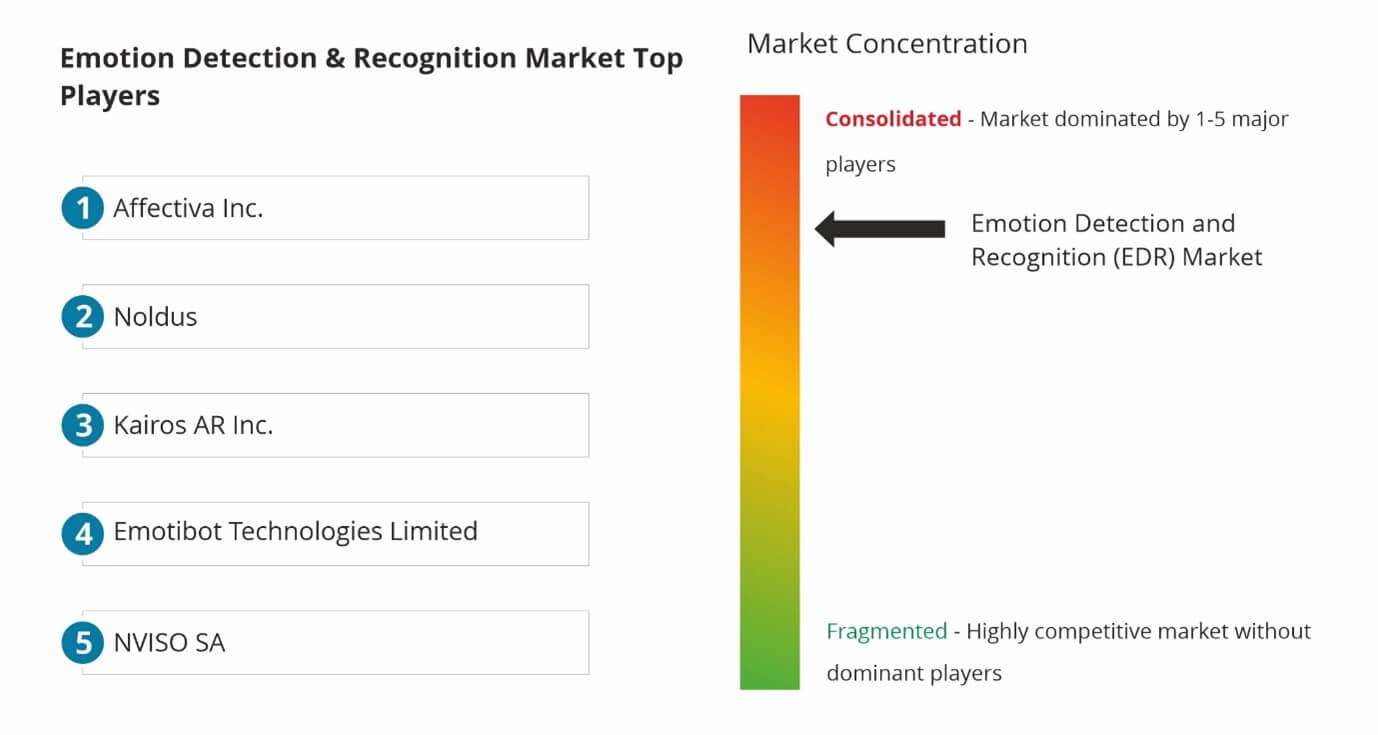
While the emotion detection and recognition market has become quite competitive due to the presence of various vendors, it also appears to be consolidated, with a few firms accounting for the majority of market share. Furthermore, due to greater investment and demand for experienced technicians, market entry for new entrants remains difficult. Some of the market’s major players are Affectiva Inc., Noldus, Realeyes OU, and Kairos.
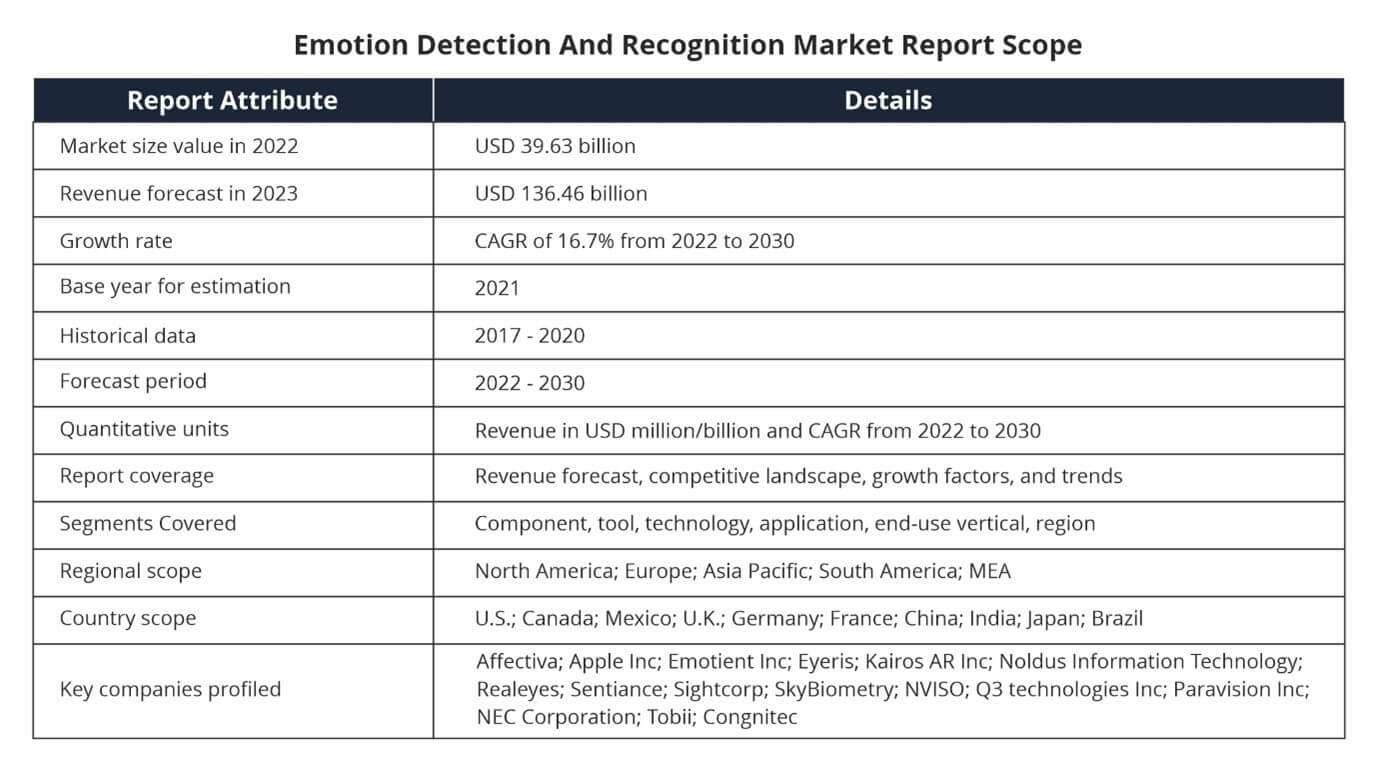
In terms of revenue, North America held the largest revenue share of 30.6% in 2021. The rapid growth of the Internet of Things (IoT) and the growing popularity of wearable devices with advanced technology provide enormous opportunities for the regional market. In the Asia Pacific region, developing countries, such as India and China, are expected to experience increased demand for expanded technology rollout and strategies to develop uniform and effective emotion detection and recognition systems.
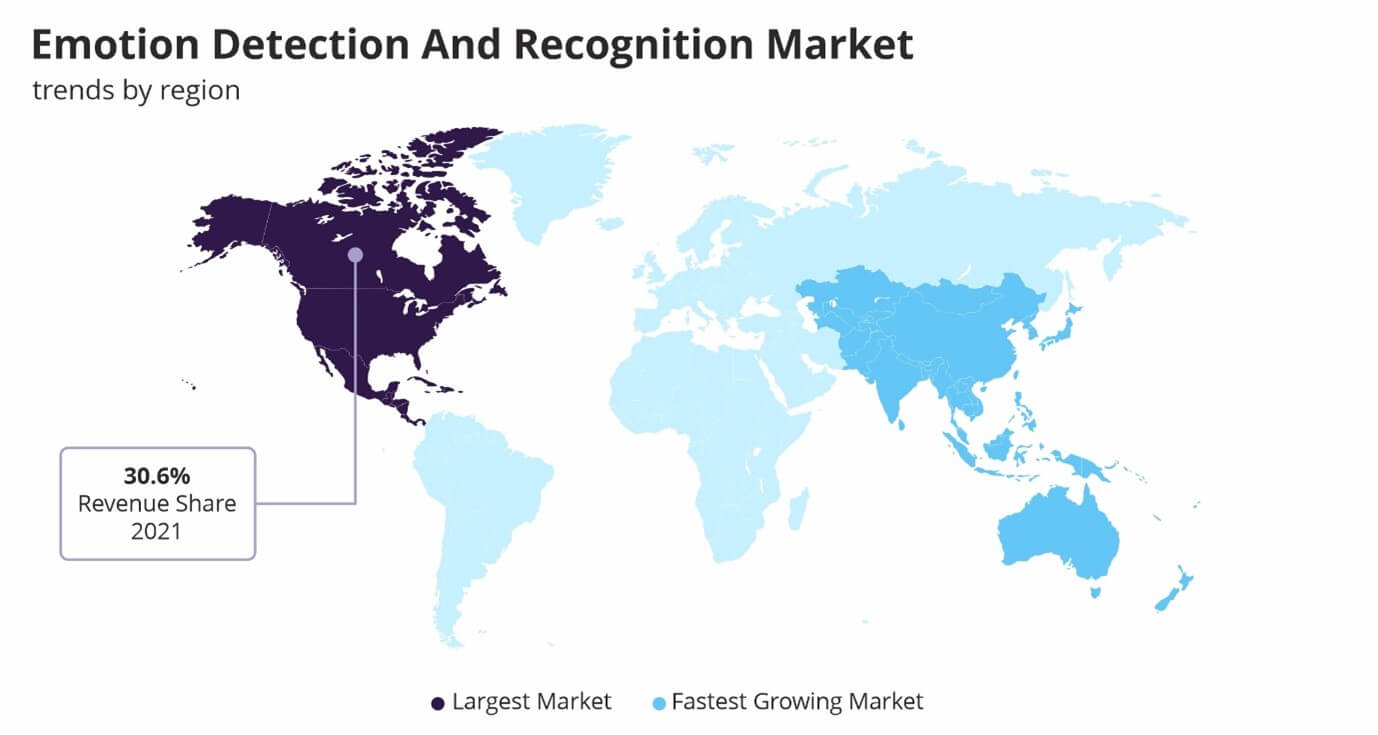
Now that we have gained an understanding of the growth of Emotional AI, let us explore the realm of intellectual property (IP) in this field.
Intellectual Property Landscape of Emotional AI
To understand the intellectual property aspect of Emotional AI technology, Sagacious IP performed a broad-level study of the companies that have invested in patent filings of this technology. Following are the findings of this study.
Year-wise Patent Filing Trend
The below graph showcases the number of patent filings related to Emotional AI technology from 2013 to 2023. The years 2020 and 2021 have topped the total number of patents filed in the Emotional AI domain.
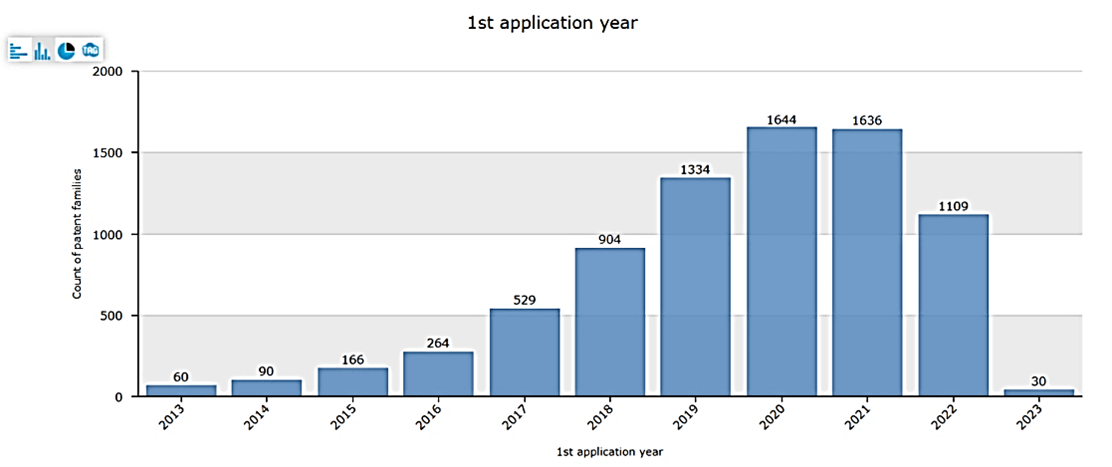
Top Assignees
The below figure represents the top patent assignees in the Emotional AI domain. IBM is the leading player with the highest number of patents under its name, followed by Tencent Technology, Samsung, and Pingan Technology. Accenture, Microsoft, Huawei, Amazon, and Google also have a significant number of patents assigned to their name.
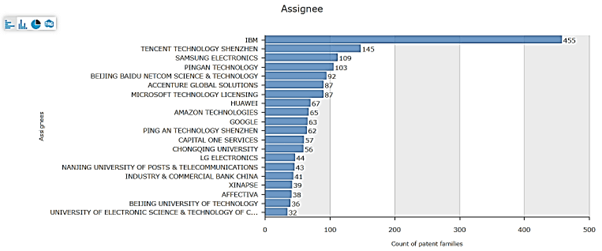
Top Assignee Vs Filing Year Trend
The below graph represents the top assignees and the number of patents filed by these assignees in a particular year. IBM appears to have a boom in patent filing between 2017 and 2021. In comparison, other companies are constantly filing patents related to Emotional AI.
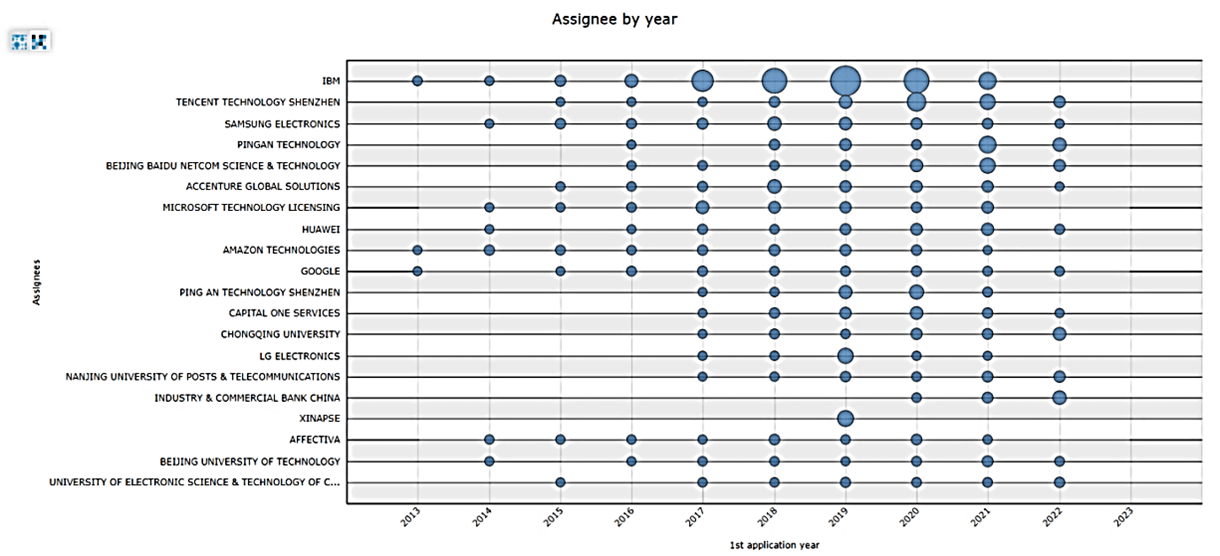
Patent Filing Trends by Jurisdiction
The below figure represents the number of patents filed in the Emotional AI domain in a particular jurisdiction. China has topped the chart, followed by the USA, Europe, Korea, and India.
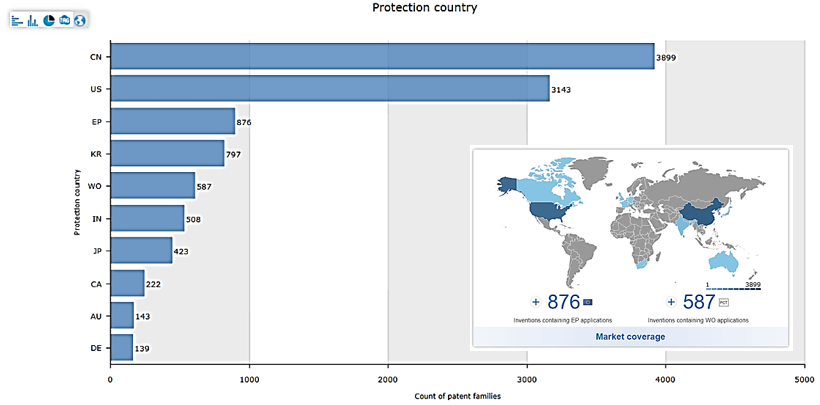
Jurisdiction Vs Assignee Filing Trend
The below graph illustrates jurisdictions where top assignees have filed patents. Although most companies have a high proportion of their patent filings in China, IBM has filed the greatest number of patents in the US, while the remaining companies have a constant filing in China, US, South Korea, and India.
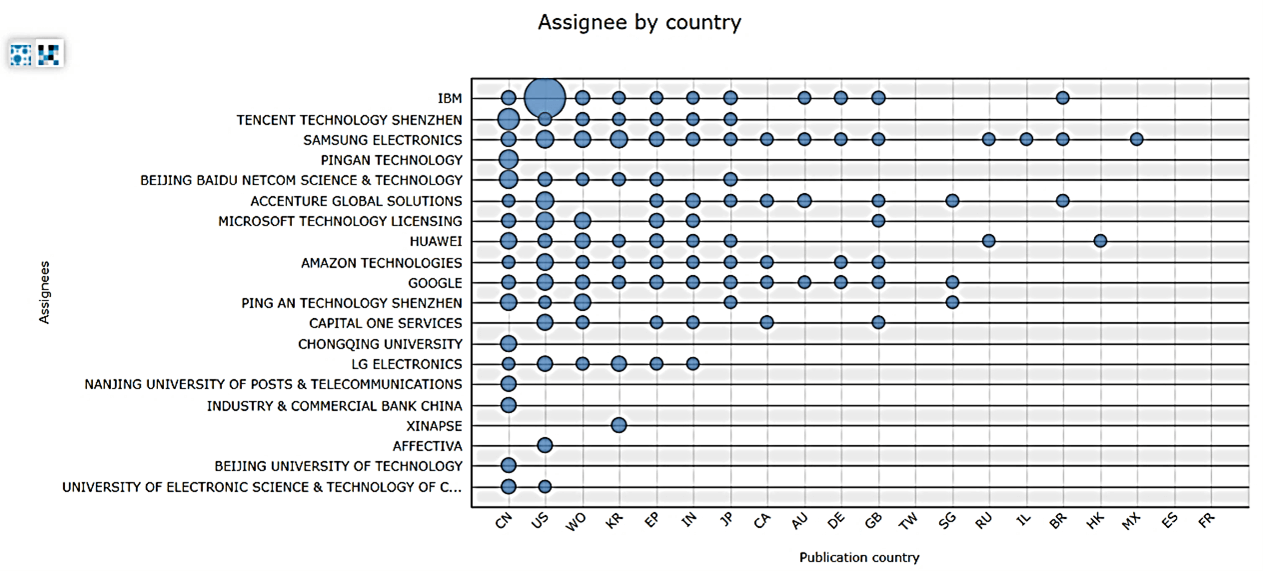
The following section delves into the future of Emotional AI, which offers immense potential as it continues to progress and influence the landscape of human-machine interaction.
Future of Emotional AI
The future prospects of Emotional AI are incredibly promising, and it is poised to become a massive multibillion-dollar industry, with a few speculating it even reaching the trillions. Emotional AI is becoming more sophisticated and capable with advances in machine learning, natural language processing, and computer vision. Giants like Amazon and Google have also begun tapping into the use of Emotional AI, and rapid growth the industry will likely see rapid growth in the next few years.
The roadmap for the future of AI will see businesses utilizing emotional analytics to make their decisions. From improving the way we tackle mental health to revolutionizing industries such as customer services, the implementation of Emotional AI will have a significant impact. Combined with the growth of new wearable smart devices (smart glasses or smart watches), an implementation of Emotional AI might also be there in our everyday day-to-day objects. As the use of Emotional AI expands, experts predict that several fields that demand human emotional competence, such as recruiting, counseling, etc., may not see as much demand in the coming decade.
Conclusion
Emotional AI is a rapidly growing and exciting field with a bright future. Its ability to understand and respond to human emotions is changing the way we interact with the world and each other. It has immense potential to improve various industries and aspects of our lives. As technologies advance, the world will see rapid growth in this space and improved Emotional AI. One can rightfully say that emotional AI is going to play an essential role in shaping the future of human-computer interactions and building a new era of technology.
Sagacious IP offers technology scouting service that facilitates the building and management of a robust patent portfolio, whether it encompasses Emotional AI innovations or other technological domains. We have established partnerships with various multinational companies to safeguard their intellectual property as technologies within their respective fields. To learn more about our expertise, we invite you to visit our technology scouting service page.
– Nishant Kaushik and Aditya Dhankhar (ICT Licensing) and the Editorial team
Having Queries? Contact Us Now!
"*" indicates required fields




